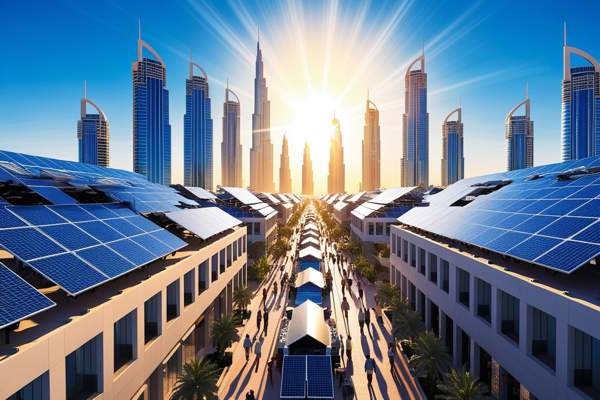
Visually Transforming the Urban Sprawl
Dubai's iconic skyline, once solely defined by architectural marvels and shimmering glass towers, is gradually undergoing a subtle yet significant transformation with the increasing integration of solar energy. Rooftop solar panels, once perhaps an afterthought, are becoming an increasingly common sight, adding a layer of sustainable technology to the urban fabric. While large-scale solar parks like the Mohammed bin Rashid Al Maktoum Solar Park are located on the city's periphery, the cumulative effect of distributed solar installations on buildings across Dubai is contributing to a greener visual identity. This integration of renewable energy infrastructure into the urban landscape signals a commitment to sustainability that is becoming increasingly visible to residents and visitors alike, subtly reshaping the perception of Dubai as a forward-thinking and environmentally conscious city.
The most significant environmental impact of solar energy adoption in Dubai is the substantial reduction in its carbon footprint. By displacing electricity generation from traditional fossil fuel sources, solar power directly contributes to lowering greenhouse gas emissions, a primary driver of climate change. This shift towards cleaner energy has tangible benefits for air quality within the urban environment, reducing the levels of harmful pollutants associated with burning fossil fuels. As solar energy contributes a larger share to Dubai's energy mix, residents can expect cleaner air and a healthier living environment. This ecological benefit is a crucial driver behind Dubai's commitment to expanding its solar energy capacity and fostering a more sustainable urban ecosystem.
Large-Scale Solar Parks and Land Use Considerations
The development of massive solar parks like Noor Dubai, while crucial for meeting ambitious renewable energy targets, also presents considerations related to land use and potential ecological impacts on desert ecosystems. Careful planning and environmental impact assessments are essential to minimize any negative effects on local flora and fauna. Implementing mitigation measures, such as habitat restoration and responsible land management practices, is crucial for ensuring that the transition to solar energy is environmentally sound in its entirety. Balancing the need for large-scale renewable energy generation with the preservation of natural desert environments requires a thoughtful and strategic approach to land allocation and project development.
The proliferation of rooftop solar installations directly contributes to the sustainability of individual buildings and neighborhoods. By generating clean energy on-site, buildings reduce their reliance on the centralized grid and their associated carbon emissions. This localized energy generation can also enhance energy independence and resilience, particularly when coupled with battery storage systems. Furthermore, the integration of solar technology can contribute to green building certifications and enhance the overall environmental performance and market value of properties. As more buildings in Dubai embrace rooftop solar, the cumulative impact on the city's overall sustainability and environmental footprint becomes increasingly significant, fostering a culture of green building practices.
Minimizing Water Usage in Energy Production
Compared to traditional thermal power plants that often require significant amounts of water for cooling, solar energy technologies, particularly photovoltaic systems, have a much lower water footprint. In a water-scarce region like Dubai, this is a significant environmental advantage. While some concentrated solar power (CSP) technologies may utilize water for cooling, advancements are being made to develop dry cooling systems that minimize water consumption. The shift towards solar energy, therefore, contributes to the conservation of precious water resources, aligning with Dubai's broader sustainability efforts in water management. This reduced water dependence in the energy sector is a crucial aspect of building a more environmentally resilient and sustainable future for the emirate.
The increasing prominence of solar energy in Dubai is not just about numbers and megawatts; it's about a tangible shift towards a greener urban landscape and a healthier environment for its inhabitants. From the subtle gleam of rooftop panels to the vast arrays of solar farms on the horizon, the visual and ecological impacts of this energy transition are becoming increasingly evident. By embracing solar technology, Dubai is not only diversifying its energy portfolio but also actively shaping a more sustainable and environmentally responsible future, demonstrating that economic progress and ecological stewardship can go hand in hand, creating a truly greener skyline for generations to come.